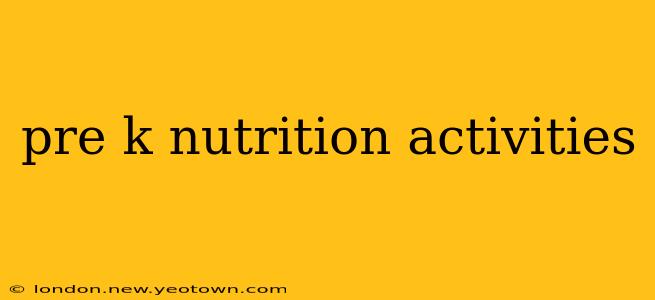Ah, preschool – a whirlwind of giggles, tiny hands, and… surprisingly, a lot of focus on nutrition! Getting pre-K kids excited about healthy eating isn't about forcing vegetables down their throats; it's about making healthy choices fun and engaging. This journey begins with creative, interactive activities that turn nutrition lessons into memorable experiences.
Let's dive into a world of colorful fruits, playful veggies, and activities that will leave both you and your little learners feeling nourished and happy!
What are some fun ways to teach pre-K kids about nutrition?
This is the golden question, isn't it? The key is to make learning an adventure. Forget dry lectures; think interactive games, sensory explorations, and delicious hands-on experiences. We'll explore some great options below!
How can I make a healthy snack fun for preschoolers?
Making healthy snacks fun is all about presentation and participation. Instead of just handing out a piece of fruit, let's get creative!
- Fruit Kabobs: Threading colorful fruits onto skewers (child-safe, of course!) turns snack time into an art project. The kids get to choose their favorite fruits and proudly display their creations.
- Veggie Faces: Use whole-wheat crackers as a base and let the kids create funny faces with carrot slices, cucumber sticks, and bell pepper triangles. It’s a healthy, creative, and delicious masterpiece!
- Ants on a Log: Celery sticks filled with peanut butter (or sunflower seed butter for allergies) and topped with raisins are a classic for a reason – they're fun to eat and packed with nutrients.
What are some nutrition activities for preschoolers at home?
Home is the perfect place to plant the seeds of healthy eating habits!
- Grocery Store Scavenger Hunt: Turn your weekly grocery trip into an exciting game. Give your preschooler a list of healthy foods to find (e.g., a red fruit, a green vegetable, a whole-grain bread). This teaches them about different food groups in a practical way.
- Grow Your Own Veggies: Even a small herb garden or a few easy-to-grow vegetables like cherry tomatoes or radishes can spark a child’s interest in where their food comes from. Watching something grow from seed to harvest is incredibly rewarding.
- Cooking Together: Involve your child in simple cooking tasks like washing vegetables, stirring ingredients, or measuring out portions. This not only teaches them about food preparation but also makes them more invested in the meal.
What are some games to teach kids about healthy eating?
Games can transform learning into a playful experience!
- Food Group Bingo: Create bingo cards with pictures of different food groups. Call out the foods, and let the children mark them on their cards. This reinforces the importance of a balanced diet in a fun way.
- Healthy Eating Charades: Act out different healthy foods or eating habits, and have the children guess what you're portraying. It’s a great way to get them moving and thinking about healthy choices.
- Nutrition Matching Game: Make pairs of cards with pictures of foods and their corresponding food groups. Children can match the foods to their correct groups, strengthening their understanding of food classifications.
What are some classroom activities to teach preschoolers about healthy eating?
The classroom offers opportunities for collaborative learning and exciting group activities!
- MyPlate Crafts: Have the children create their own MyPlate using construction paper, cutouts, and drawings of their favorite healthy foods. This visual representation reinforces the concept of balanced meals.
- Healthy Food Taste Test: Introduce children to new fruits and vegetables with a guided tasting. Encourage them to describe the taste, texture, and color of each food item.
- Classroom Garden: A class garden, even in pots, is a fantastic learning opportunity. Children can participate in planting, watering, and harvesting, connecting directly with the food they eat.
Remember, consistency is key. By incorporating these fun and engaging activities into your routine, you can cultivate healthy eating habits in pre-K children that will last a lifetime. It’s not just about nutrition; it’s about creating positive associations with healthy food and fostering a lifelong love of eating well!

